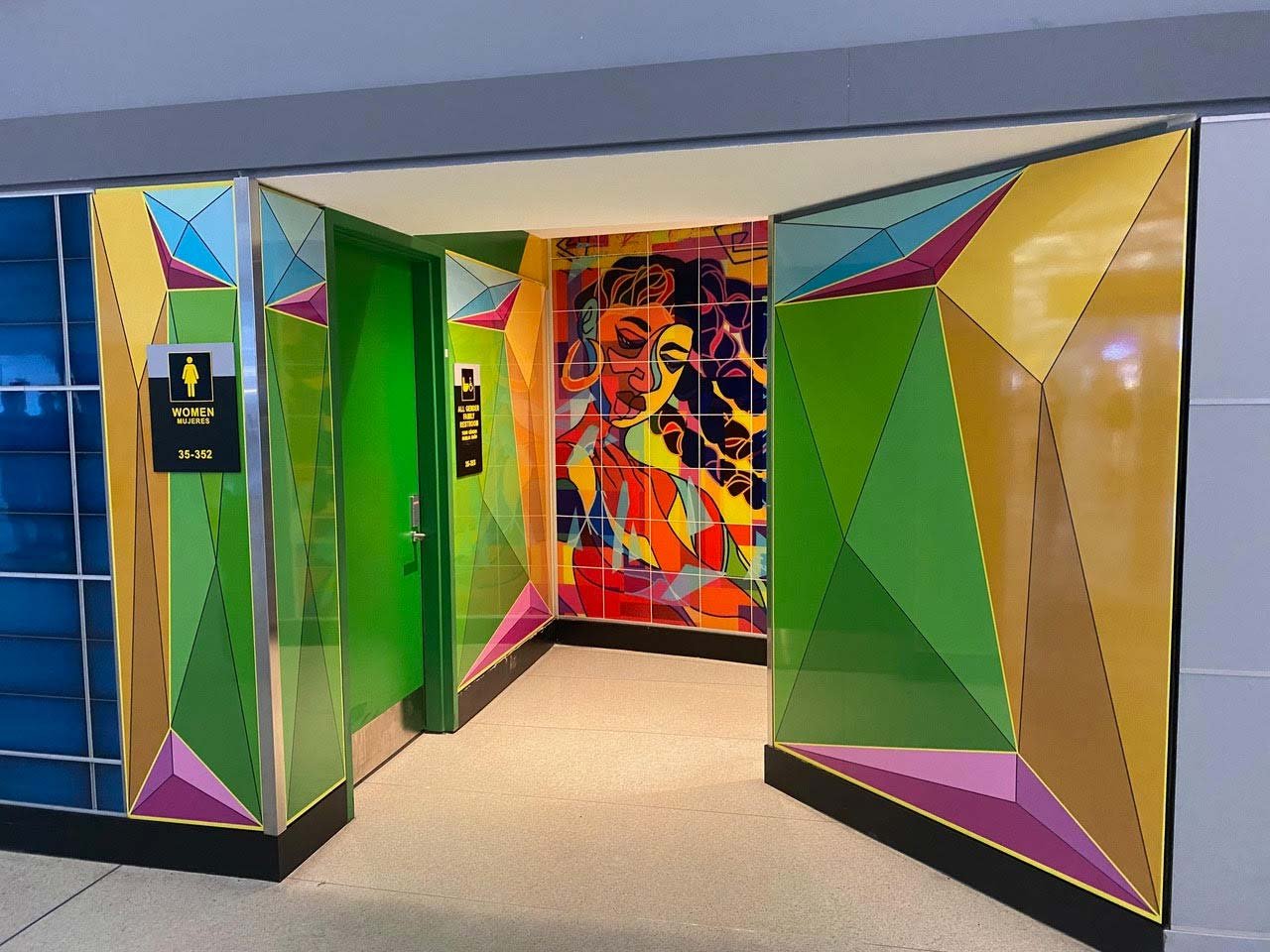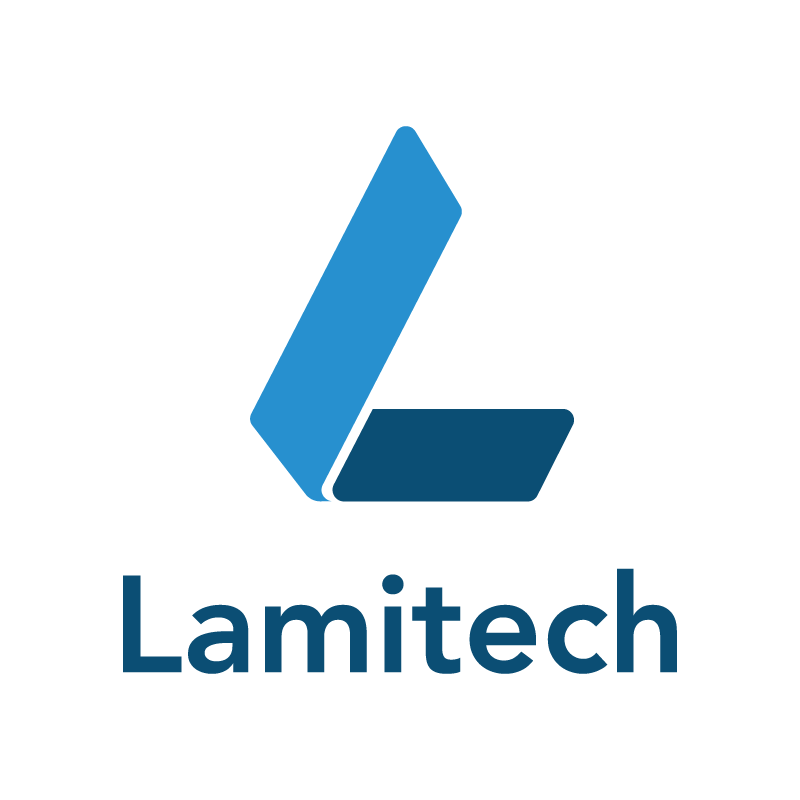Compact Laminate
Also Known As: Solid Phenolic, High-Pressure Compact Laminate
Compact laminate was used in this carbon neutral restroom at JFK Airport, terminal 8. Photo courtesy of surfacematerials.com
What is Compact Laminate?
Compact laminate is simply a thicker version of HPL and is sold in panels and finished components. It’s 70 percent paper, saturated with thermoset plastic resins bonded together under heat and pressure.
Compact laminate is incredibly durable and rigid, and unlike HPL it does not require a substrate; it is a homogenous, self-supporting, stand-alone material ideal for many of the most demanding of applications, interior or exterior.
The name “compact laminate” refers to the material’s extreme density, and its makeup of many layers of resin-saturated kraft paper bonded together through lamination. Although “laminate” is in its name, compact does not require bonding to a substrate. It is a freestanding decorative panel that requires only limited support when used in large formats like countertops and conference tabletops.
Compact does not require specialized tools; it can be worked with standard woodworking equipment.
Why Compact Laminate?
Compact is for the extremes: laboratory tops and cabinetry, panels in public buses or trains, airport wall panels, exterior wall claddings of multi-story commercial buildings who want longevity without maintenance concerns, outdoor kitchens, table tops or restaurant servers, keyboard trays, restroom cubicles and much more.
The machined edges of a sheet of compact are warmer and smoother to the touch than solid surface materials, and the decorative faces can be specified in a wide range of colors, designs, and custom digital prints, to match or complement other materials in a product or project.
Because it consists of mostly paper made of carbon-storing wood fiber, compact stores more naturally captured carbon than is release in its production and use, making the material Climate Positive Now.
It can best be described as a paper fiber-based solid surface material, with a softer feel, warmer touch and better span-holding strength than acrylic or polyester-based materials, which have a tendency to sag under their own weight.
Compact Laminate is a simple material for fabricators to use and a revolutionary idea for the design community, to solve design, durability and ecological challenges all with one choice.
Where is Compact Laminate used?
Commercial Interior Wall Claddings
Commercial or Residential Exterior
Transaction Counters
Conference Tables
Indoor and outdoor dining tables
Laboratory Counters and Cabinetry
Cutting boards
Toilet Partitions
Commercial Counter and Island Tops
Residential Countertops
Outdoor Signage
Public Transportation Components
Fretboards for guitars and other string instruments
Commercial: Compact Laminate is used in hospitality, multifamily, and institutional academic and scientific settings, for any surface that will be subject to the elements and/or needs to be low maintenance.
Residential: Countertops, tabletops, island tops, and outdoor kitchens.
Compact Laminate Properties and Performance
Fast renewable, Paper fiber-based solid surface option
Qualifies as Climate Positive – Sequesters more car
Nonporous, Hygienic and Anti Microbial
Exceptional scratch & impact resistance
Water resistant
Rigid – requires no substrate or structure for horizonal applications
Easily worked with standard woodworking equipment
Wide range of designs and textures available
High resistance to chemicals such as alkalis, acids and strong oxidizers
Fire retardant
Dimensionally stable
Resist pests, mold, fungi and bacteria
“Color-through” options have the same color through the depth of the panel
HPL is often used as a more durable, economical alternative to veneer and stone surfaces in high-use applications.
Compact Laminate Design
Surface Visuals: Décor papers used in compact are essentially the same as used in HPL and TFL. They’re printed on décor papers either on rotogravure or digital inkjet presses with water-based inks. In some cases designers prefer to forego a decorative paper on the panel face, allowing the organic look of the brown kraft paper to show through. Some manufacturers also use colored paper throughout the core to create solid-color panels.
Textures: Woodgrains, gloss/matte variations and other texture effects are imparted to the surface during pressing, using either engraved steel plates or textured release papers. Some of these textures may be “synchronized,” meaning the “ticks” in a woodgrain or texture variations in stone, for example, align perfectly with details in the décor paper. Compact laminates can carry deeper texture details than some other materials.
Shapes/Form: Compact laminates are produced as panels. Because of their homogenous makeup they can be shaped much like stone or solid surfaces, with fine edge details, interior cutouts and under-mount sinks.
Edges: Because of their extreme durability, the edges of a compact panel do not require additional edge treatments. Machined compact edges are very smooth and are considered one of the material’s selling points.
Matching Materials: Compact producers publish guides to design matches in complementary materials – TFL, 3DL, decorative paper foils, and edge treatments. HPL is commonly combined with TFL and 3DL to increase design flexibility and to value-engineer the performance required for each surface.
Material Makeup and Manufacturing
The core of a sheet of compact is made of several layers of kraft paper (similar to shopping bag paper, produced increasingly from recycled content) saturated with phenolic resin. The visual layer is usually a sheet melamine-impregnated décor paper with a solid color or printed design.
The layers of saturated paper are fused together under 1,000 lbs. psi and temperatures of 320 degrees F in a large press using embossed steel plates to impart texture to one or both faces. Once cooled and cured, compact is ready for shipping and use.
Compact Laminate Component Fabrication
Compact milling techniques are similar to hardwood plywood or solid wood in standard woodworking operations. Once machined, compact is ready for use – no further lamination or edge treatments are required, minimizing labor hours per component.
Environmental Impact
The makeup of compact laminate is 70% paper made from wood fiber, which itself is composed of 50% naturally captured carbon. The material is therefore naturally Climate Positive Now because it sequesters more carbon than is released in its production and use.
Certifications
EPD / LCA
Carbon Neutrality
Greenguard Gold
FSC
Recycled content
Compact Laminate Suppliers
Arborite
Arpa
Formica
Kronospan
Lamitech
Panolam
Trespa
Wilsonart









